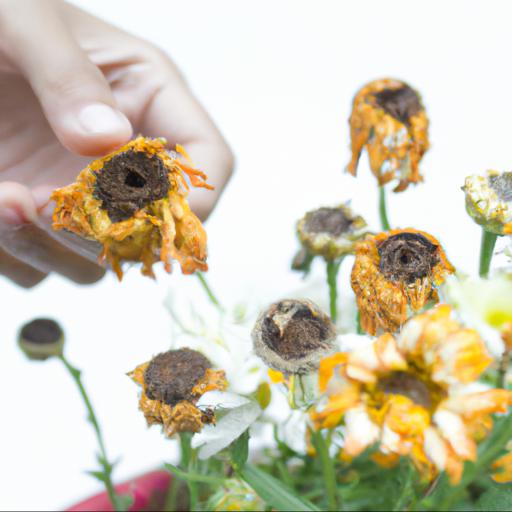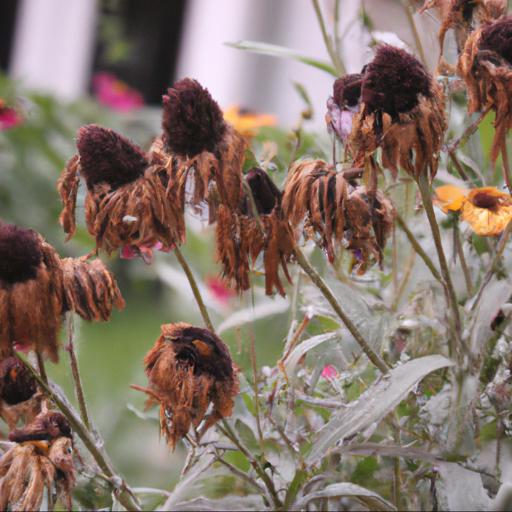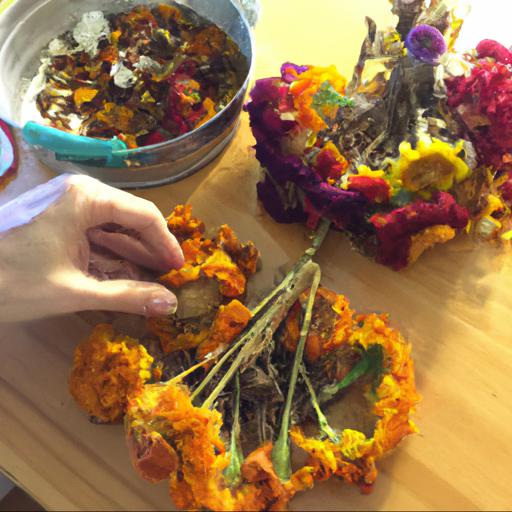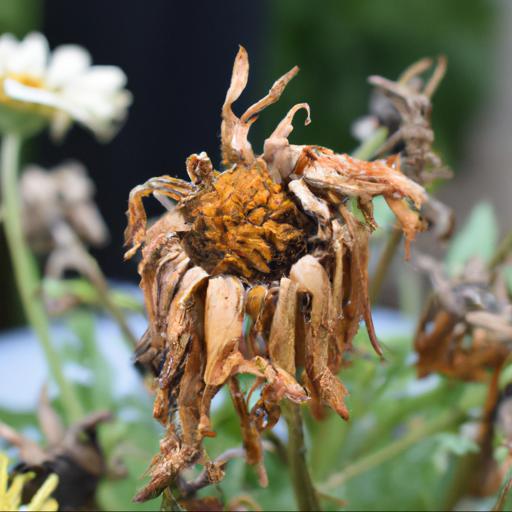Deadheading flowers is a great way to keep your garden looking vibrant and healthy. It can be a tedious task, but the rewards are worth it.
In this blog post, we’ll explore six reasons why you should deadhead your flowers. By deadheading, you’ll be able to increase the growth of your plants, reduce the spread of disease, and enjoy a beautiful garden all season long. So, let’s get started and learn why deadheading your flowers is so important.
What is deadheading

Deadheading is an essential part of garden maintenance and has numerous benefits. It’s the process of removing spent flowers and seed heads from the plants. As unappealing as it may seem, there are a variety of reasons why you should deadhead flowers in your garden.
Firstly, it encourages new and more plentiful flower blooms. When you deadhead flowers, you’re providing energy for the plant to focus on new growth rather than old flowers and seed heads.
By removing spent blooms, you’re giving the energy for the plant to produce flowers, thereby creating a much more vibrant and attractive display. For example, you can keep rose bushes blooming all summer by removing the dead blooms and leaving the buds behind to continue flowering. In addition, deadheading helps to promote shorter, bushier plants.
By removing the flowers and seed heads, you’re removing the taller spots, allowing the plant to focus its energy more evenly throughout. The result is a much more filled out, full-looking plant that’s less lanky and straggly, making your garden look lush and well-maintained.
Finally, deadheading can also reduce the spread of diseases, pests and weed. By trimming away any diseased flowers and seed heads, you’re allowing the plant to remain healthy and disease-free.
It also helps you to keep overgrown plants in check, preventing them from becoming too large and too unmanageable. For all of these reasons, it’s essential to make deadheading a part of your regular garden maintenance routine. It can significantly improve the overall appearance of your garden and keep your plants healthy and vibrant.
So, don’t delay – start deadheading flowers today and enjoy the benefits!
Benefits of deadheading

As a UK garden expert, I am often asked: why should I deadhead my flowers? There are many reasons why I highly recommend regular deadheading in order to keep your garden looking beautiful and vibrant. Here are my top six reasons to deadhead flowers:
Deadheading helps to encourage healthier and fuller growth. Pruning back spent blossoms not only maintains the aesthetic look of a garden, but it also encourages the flowers to produce more abundant and larger blooms.
This is especially helpful for perennials like phlox, asters, mums, and daylilies, which are known for their prolific blooming habits. Deadheading helps to prevent the spread of diseases.
Many types of disease-causing organisms prefer to over-winter in spent flower heads. Regularly removing the spent flower heads can help to reduce the spread of disease to other flowers and plants nearby.
Deadheading lengthens the flowering season.
By helping to encourage fuller and more abundant growth, deadheading also helps to extend the flowering season of plants, providing you with more weeks or months of enjoyment for your flowers. Deadheading can help preserve plant resources.
As plants naturally attempt to direct their energy and resources toward seed production, deadheading can divert those resources back towards producing flowers, thus keeping your garden looking fresh and inviting. Deadheading can reduce maintenance needs. Regularly pruning back spent flowers helps to contain the growth of certain plants and can reduce the need for future pruning and trimming. Deadheading can be therapeutic and enjoyable. There’s something almost meditative about deadheading, getting up close to the garden and seeing the buds and blossoms in detail. It can be a pleasant break in any garden maintenance routine, allowing you to take a moment to appreciate the beauty and life that your garden brings to your home. So, whether you’re looking to preserve resources, reduce maintenance needs, spread beauty, or just spend a relaxing afternoon in the garden, deadheading is a great habit to take on. Start today and watch your garden transform and thrive right before your eyes!
How to deadhead flowers

. Deadheading flowers is an essential element of gardening which allows gardeners to prolong the flowering period of their flowers and make sure the blooms that have faded away are removed.
In this blog I will provide six reasons to why you should deadhead your flowers. Firstly, deadheading flowers encourages new growth and blooms. As soon as the flowers have finished blooming, it is important to remove the wilting heads or lower leaves as they take up valuable energy and resources that the plant could otherwise be reserving for new growth.
This will allow more of the plant’s resources to be devoted to the creation of new blooms and encourage more prolific flowering. Secondly, deadheading prevents the formation of seeds and hence restores the natural beauty of the flowers.
Many flowers grown for decorative purposes often lose their blooms before the process of seed production can start. Deadheading prevents the production of seeds and allows the next generation of flowers to bloom without being crowded by the offspring. Thirdly, when flowers are deadheaded, the overall appearance of the garden is improved.
Dead and wilting flowers cast an overall gloomy sight and can spoil the beauty of a garden. Removing the dead flowers can significantly improve the overall appearance of the garden by preserving the beauty of the flowers before their time has come. Fourthly, by removing old blooms it helps to prevent diseases.
Fungal diseases can spread to other flowers through the wilted blooms, thus deadheading can help to reduce the risk of diseases and make sure the garden remains healthy. Fifthly, deadheading can help to keep the soil in a neat and tidy state.
Wilting flowers can often leave behind dead parts on their stems which can start to look unsightly and deteriorate the soil. Hence, regular deadheading is essential to keep the soil neat and clean. Finally, when done correctly, deadheading flowers is a stress-relieving activity that helps to bring peace and joy to the gardener. It allows you to sit back and enjoy the nature, give your flowers the care they need and take in the view of your wonderful garden. In conclusion, deadheading flowers accurately and regularly is really important as it can prolong flowering, prevent diseases, and help maintain the beauty of your garden The above six reasons explain why deadheading is an essential element of gardening and why you should undertake this activity regularly.
Tips for deadheading
Deadheading is a gardening technique that many gardeners swear by. The process of deadheading involves removing the spent blossoms of annual and perennial plants.
This practice helps to keep plants looking vibrant and healthy. In addition, it can help encourage the production of new, healthy flowers. Here are six reasons why deadheading is a beneficial process for keeping your garden looking its best.
First and foremost, deadheading can provide more flowers for your enjoyment. By removing the flowers that have already bloomed, more energy is devoted to the formation of new flowers rather than the production of seed. The result is more vibrant, plentiful blooms.
Secondly, removing spent flowers will help prevent self-seeding, as well as the spread of potentially invasive species. By eliminating flowers before they can form a seed pod, you can control the spread of certain plants that may otherwise take over the whole garden.
Thirdly, deadheading can help keep your garden looking neat and clean. Dried flowers are often unattractive and can detract from the beauty of the rest of your plants.
Lastly, deadheading can help to minimize pest infestations. Many insects and diseases migrate to dying flowers and can, ultimately, spread to the surrounding foliage. By removing spent flowers, it can help to keep your garden safe from these all too common problems.
Finally, deadheading can help create healthier plants. By removing spent flowers, it can encourage more efficient growth and help allocate vital energy reserves to areas on the plant that still need it. So, when it comes to caring for your garden, don’t forget to deadhead regularly. With these six reasons in mind, you can be sure to reap the most enjoyment from your garden.
Deadheading and why is it important
Deadheading flowers is a form of routine care essential to the health of a garden. It involves the removal of faded, dead or unwanted blooms or foliage on flower-bearing plants, such as roses and geraniums.
This easy task encourages plants to develop new blooms, increases the blooming period and improves the appearance of the garden. Here are six reasons why deadheading is so important. Firstly, it eliminates seed heads, which stops them from pollinating and maturing.
This allows the energy of the plants to be used on creating new buds and blooms. Secondly, it encourages new growth as it stimulates plants to make more energy, which results in fresher, brighter blooms.
Thirdly, it allows overwintered flower stems to be trimmed back, making way for days of new foliage and flowers. Fourthly, removing old flowers protects plants from harboring diseases. Deadheading helps to reduce the spread of pests and bacteria which often become more common when plants are weakened.
Fifthly, it prevents disorganized and overcrowded plants, which can be problematic as overcrowded plants can fail to thrive. Lastly, a regular deadheading can encourage your flowers to bloom continually throughout the warmest seasons, providing a garden with a bright, beautiful display. Deadheading is an easy, efficient way to keep your garden in optimal condition.
It requires minimal effort but the benefits are long lasting. By regularly cutting away wilted flowers, you can ensure your garden maintains its health and vitality while looking blooms glorious!
Six reasons to deadhead flowers
When undertaking gardening projects, deadheading is an essential maintenance strategy for many of the plants in your garden. Deadheading flowers can extend the life and beauty of your garden and help to keep plants looking and growing at their healthiest.
Here are six reasons why you should deadhead your plants regularly: Improve Plant Health: By deadheading your plants and removing the seed heads, the plant will devote more energy and focus to continuing to create healthier flowers and foliage, instead of wasting its energy on producing the seed heads. In addition, by ensuring that the nutrient supply is always at its optimal level, deadheading will help to maintain healthier plants and an overall more vibrant, beautiful garden.
Stronger Growth: Deadheading will help tokeep your plants growing stronger and healthier. Materials such as phosphorus that are important to a plant’s growth are found in the seeds heads, so when they are removed, the plant will be able to take more of this material and use it for healthy growth.
Continuous Color: Deadheading your flowers will help to maintain the color of your garden.
After flowering, the blooms begin to fade and become dull, which can impact the overall look of your garden. This is because without pruning, the old blooms will draw energy from the flowers.
Once the old blooms are pruned, the plant will be able to put all of its energy into forming new and vibrant blooms for your garden. Improved Structure: Over time, many flowers will become leggy and spindly, ultimately reducing their beauty.
When flowers are deadheaded, the shape of the plant will remain fuller and more structured. This will help the whole garden to look more aesthetically pleasing. Encourages New Blooms: By removing the old blossoms, the plants will devote more of its nutrients to creating new blooms. This helps to keep the garden looking fresh while also making the most of the space. Reduced Re-seeding: After a flower blooms, the plant will naturally start to create seeds. This can cause the plant to re-seed in the same area repeatedly which can lead to overcrowding. This not only reduces the amount of space that the other plants have but can also lead to an imbalance of nutrient distribution, as the plants may not be receiving an equal amount of nutrients. By deadheading, you can help to prevent this and ensure that your garden is kept well maintained. When maintaining your garden, deadheading is an important part of the process to ensure that it remains healthy and vibrant. With all the benefits that come from deadheading, such as improved structure, healthier plants, and continuous color, it is a task that should definitely not be overlooked.
How to deadhead different types of flowers
and content should be minimum 600 words Are you familiar with the term ‘deadheading’? If you’re an avid gardener, like myself, you may have heard it used a few times but have been unsure exactly what it is. Deadheading is an important horticultural term that refers to the practice of removing old, dead or wilting flowers from plants.
It is a simple way to not only improve the aesthetic of your garden, but also to encourage the growth of fresh flowers and new branches. Here are six reasons why deadheading your flowers can drastically improve their lifespan.
First, regular deadheading helps to ensure that plants don’t become overcrowded. Continual growth leads to taller and fuller plants with consistent blooms. When this practice is neglected, plants can become overcrowded and congested, leading to wilting and potential disease.
Deadheading regularly will keep the flowering of your plants consistent and healthy. Second, when you deadhead your plants, you are effectively allowing them to reallocate the energy that would have gone towards using at the flowers that have died and use it towards the development of new buds.
This process makes the new wilting flowers less likely to occurred and prevent a lack of blooms. Third, deadheading flowers can help prevent the spread of any diseases that could be present in the deadheads. It’s a great way to prevent infection from spreading to the other flowers or to other plants.
It’s also important for protecting them from pests and to keep the overall integrity of your garden looking great. Fourth, deadheading can also make your plants look more attractive.
By removing the dead flowers, it opens up the opportunity for other flowers to expand, putting them in your line of vision making them more attractive. Fifth, deadheading can also encourage more blooms. By doing so, more energy is being diverted to new flowers which will provide more blooms throughout the year. Lastly, it is generally believed that deadheading flowers encourages more flowers, leading to more bees in the garden. This can be beneficial for the environment as bees provide pollination, leading to more plants and blooms throughout your garden. By now, you should be aware that deadheading flowers is an integral part of your gardening routine. Deadheading can help elevate your garden in several ways; from discouraging diseases, to providing more blooms and making it look more attractive. Spend a few minutes per week deadheading your plants to ensure that you can keep it vibrant and healthy all summer long.
Tips for deadheading flowers successfully
Deadheading flowers is a great way to maintain a healthy, flourishing garden. As garden experts from the UK, we understand how important this task is for ensuring that your flowers look their best. Deadheading flowers helps to promote healthy growth and extend the flowering season.
Here are six reasons why you should make deadheading flowers a part of your garden maintenance. Firstly, deadheading allows your plants to put all their energy into growing stronger and more vibrant blossoms, not producing more dead blooms.
When you remove the old, spent flowers, your remaining healthy flowers will be able to use all the resources it needs to thrive. Deadheading also helps to prevent the spread of diseases and infestations, since the plant won’t be expending energy on dead flowers.
Secondly, deadheading flowers encourages a fuller, more abundant bloom. As you remove the wilted petals from the plant, you’re also removing the seed pods that could limit future blooms. If you don’t deadhead, you will find that your floral display will soon become far less impressive.
Thirdly, deadheading helps to keep your plants looking fresh. As the wilted petals and seed pods continually open and close, they will become increasingly unsightly. By promptly removing them and allowing the blooms to remain vibrant and vibrant, you can keep your garden looking neat and inviting.
Fourthly, when you deadhead flowers regularly, they will remain in bloom for longer. As the spent blooms and seed pods are removed, the plant will be able to focus more energy on generating more new flowers rather than producing seedpods.
Fifthly, when you deadhead flowers, you also help to encourage new growth. As the flowers wilt and fade, they often hide the new buds from view. Removing them will help to expose any potential new flowers or foliage that may be struggling to unfold. Finally, deadheading flowers is a great way to keep your plants looking their best for upcoming occasions. If you need your garden to look its best for a family gathering or a wedding, then you’ll want to make sure that your flowers are looking vibrant and healthy, and deadheading is a great way to do that. Deadheading flowers is often seen as a laborious task, but it’s essential for ensuring that your garden looks its best. As garden experts from the UK, we understand that deadheading flowers helps to prevent diseases, encourages fuller blooms, keeps plants looking fresh, encourages new growth and helps your garden to look its best for upcoming occasions. Make sure that you deadhead flowers regularly to enjoy all the benefits.
Our video recommendation
Final Touch
Deadheading flowers is a great way to keep your garden looking its best. It encourages new growth and keeps plants looking healthy.
Here are six reasons to deadhead your flowers: it encourages new blooms, prevents plants from going to seed, helps plants conserve energy, prevents disease, keeps plants looking neat and tidy, and helps to extend the blooming season. Deadheading is a simple and effective way to keep your garden looking beautiful.
FAQ
What are the benefits of deadheading flowers?
Deadheading flowers helps to promote new growth and encourages the production of more flowers. It also helps to keep the plant looking neat and tidy, and can help to extend the flowering season. Deadheading also helps to prevent the plant from producing seeds, which can help to reduce the spread of invasive species.
How often should flowers be deadheaded?
Flowers should be deadheaded regularly, usually every few weeks or when the flowers start to fade.
What is the best way to deadhead flowers?
The best way to deadhead flowers is to use sharp scissors or pruning shears to cut off the spent blooms at the base of the stem.
What types of flowers should be deadheaded?
Deadheading is the process of removing spent blooms from a flowering plant. Many types of flowers should be deadheaded, including roses, petunias, daisies, and marigolds.
What tools are needed to deadhead flowers?
Scissors or pruners are the most common tools used to deadhead flowers.
What is the difference between deadheading and pruning flowers?
Deadheading is the process of removing faded or spent flowers from a plant, while pruning is the process of cutting back or removing branches or stems to shape or improve the growth of a plant.

